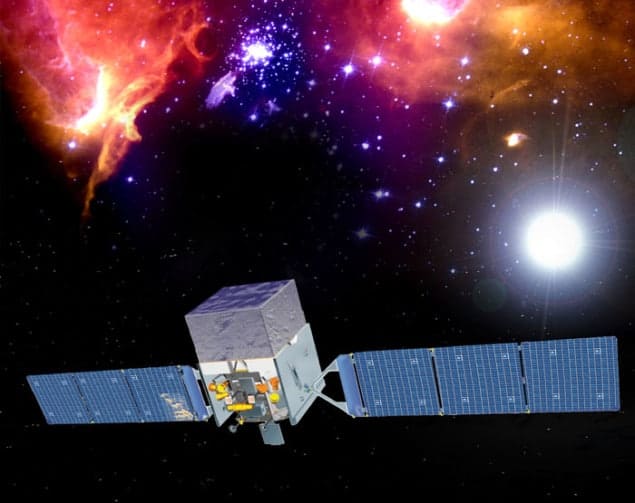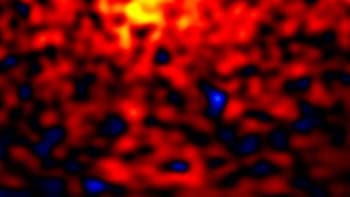
Independent analyses of data from the Fermi Gamma-ray Space Telescope have found no trace of low-mass dark matter – the mysterious substance thought to make up much of the universe. The results appear to go against recent direct evidence for low-mass dark matter, although some physicists believe there is no conflict.
Dark matter is an invisible substance thought to make up nearly a quarter of the mass/energy of the universe. While its gravitational pull is needed to explain the properties of massive structures such as galaxies, it does not interact strongly with light and has therefore yet to be observed directly. The most popular candidates for dark matter are so-called weakly interacting massive particles (WIMPs). To spot these WIMPs directly, researchers have built detectors in underground labs where the low background noise ought to allow any signals to stand out. These detector experiments include DAMA and CRESST, both based underground at the Gran Sasso laboratory in central Italy, and CoGeNT, based in the Soudan mine in the US.
For just over a decade, the team behind the DAMA experiment has claimed to see an annual modulation in its data that would be consistent with the Earth’s orbit passing through a prevailing “wind” of dark-matter WIMPs in our galaxy. Those signals were joined last year by hundreds of WIMP-like blips in the detectors at CoGeNT and, in September, a few dozen WIMP-like blips in the detectors at CRESST. Although the signals of these three experiments do not match perfectly, they seem to be pointing to a relatively light WIMP with a mass of the order of 10 GeV/c2.
Colliding WIMPs
If such a light WIMP does exist, it should leave additional, indirect evidence in data obtained by the orbiting Fermi telescope. This telescope, which is a joint mission between NASA and other international space agencies, ought to be able to record any gamma rays produced when WIMPs collide and annihilate one another. But now two independent analyses of the Fermi data have found – for at least two major types of annihilation – no gamma rays for light WIMPs.
The first analysis was done by Johann Cohen-Tanugi and others in the Fermi-LAT (Fermi Large Area Telescope) collaboration. The team used a computer model that calculates the output of known sources of gamma rays coming from the vicinity of our galaxy’s companion “dwarf spheroidal galaxies”. By comparing the model with the actual Fermi data, the researchers found no significant extra contribution from WIMPs with a mass of less than 30 GeV/c2 annihilating into either bottom quarks or tau leptons.
The second analysis was carried out by Alex Geringer-Sameth and Savvas Koushiappas of Brown University in the US. It also examines gamma rays coming from the Milky Way’s dwarf spheroidal galaxies, but it relies on a different method. The researchers use gamma rays recorded from regions surrounding the dwarf galaxies as the background, and then compare these with the gamma rays emitted from the direction of the dwarf galaxies themselves to look for a WIMP component. The analysis revealed no WIMPs with a mass less than 40 GeV/c2 annihilating into bottom quarks, and no WIMPs with a mass of less than 19 GeV/c2 annihilating into tau leptons.
Two analyses are better than one
“The two studies are complementary to each other, and they represent two different ways that one can approach the problem,” says Koushiappas. “In my opinion, the complementarity of these two papers makes the derived constraints much stronger than any single, one analysis could do.”
These constraints might appear to go against the evidence reported by DAMA, CoGeNT and CRESST, but those collaborations do not necessarily see any conflict. “One would be naively tempted to claim that there’s some tension there,” says Juan Collar, spokesperson for CoGeNT. But the type of annihilation considered by the Brown and Fermi-LAT researchers is not the one primarily being considered by those working on other dark-matter experiments. “When the exact meaning of those bounds and hints is examined, things look a lot less confusing,” he adds.
Rita Bernabei, spokesperson for the DAMA collaboration, says the DAMA signal is also compatible with WIMP masses above the new Fermi limits. “The results in the papers…are model-dependent and strong speculations should have been applied to derive such model-dependent limits,” she says. A spokesperson for the CRESST collaboration could not be reached for comment.
Underlying physics not yet understood
Michael Kuhlen, a theoretical astrophysicist at the University of California, Berkeley who was not involved with the research, also believes there is not necessarily any conflict between the Fermi data and those of the direct dark-matter searches. He says it is difficult to relate the annihilation probabilities used in the latest studies with the probabilities of WIMP interactions inferred by direct dark-matter searches without properly understanding the underling particle physics.
But are we now further from knowing what dark matter actually is? “Certainly we are not any closer,” adds Kuhlen.
The results of both the Brown group and the Fermi-LAT collaboration are due to be published in Physical Review Letters and are available as preprints at arXiv.org:1108.2914 and arXiv.org:1108.3546, respectively.



